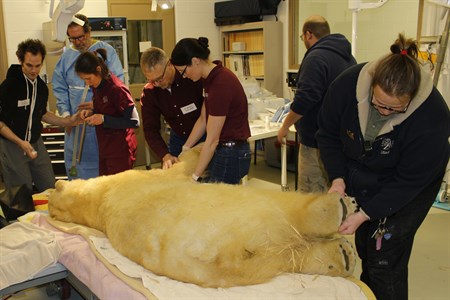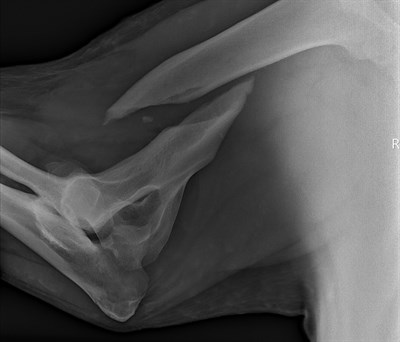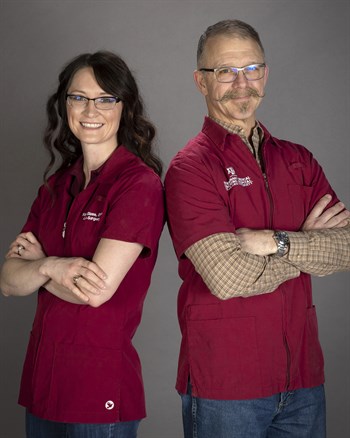Texas A&M Professors Perform First Humerus Repair On Polar Bear

As veterinary surgeons in the Texas A&M College of Veterinary Medicine & Biomedical Sciences’ (CVM) Large Animal Hospital, a lot rests in the hands of Drs. Jeffrey Watkins and Kati Glass. Sometimes their work can be a matter of life and death; other times, an animal’s quality of life may be at stake.
Perhaps none more so than when Watkins received a call from Utah’s Hogle Zoo asking for assistance with a 3-year-old, 500-pound polar bear named Nora. Either way, the pressure to perform can be intense.
Nora, who has accrued quite a following on social media because of her story—having been abandoned by her mother after birth and being hand raised by zookeepers in Ohio before making her way to Salt Lake City—was not acting herself when her keepers found that she had broken her right humerus.
After reaching out to a small animal surgeon at the University of California, Davis, the zoo was referred to Watkins, a professor of large animal surgery in the CVM, who had recently traveled to the UC Davis to repair a fractured humerus on a foal.
While Watkins had never operated on a bear, his expertise in developing specialized equipment and implants for repairing unique fractures led him to accept the challenge.
“There were many unknowns, but we were interested in trying to help if we possibly could,” he said. “We made contact and started to have a conversation about whether this might work.”
In addition to whether the fracture could be repaired, Watkins said logistics of the repair were of the utmost concern.
“First and foremost, I knew I was going to need good help, so that’s where Dr. Glass came in. Second was making sure that we had the right equipment,” Watkins said. “Then, DePuy Synthes really came through for us with some equipment that was key for us to be able to do the job.
“The Large Animal Hospital was very supportive, our department was very supportive, and with DePuy Synthes on board, it all came together,” he said.
But the challenges and concerns weren’t over.

Recognizing that they had no experience working with polar bears, and really weren’t even familiar with polar bear anatomy, Glass went to work, researching to learn all she could.
“When Dr. Glass went to the literature, she found our most useful reference for polar bear anatomy was 1880; so, there was really no reference material for us to go on,” Watkins said.
“There are a lot of really neat things about polar bears that now I know,” Glass said. “It turns out, they’re pretty similar to grizzly bears, evolutionarily speaking. They’re kind of cousins on that front.”
She also learned that from a veterinary standpoint, polar bears are treated, most often, like a dog. However, Glass and Watkins knew that a traditional dog approach would not be a viable option.
“Most importantly, the implant we were relying on to fix the fracture needed to actually fit a polar bear and it needed to be something that would be strong enough to handle her weight,” Glass said.
While working to answer those basic questions, Glass discovered that Nora is famous.
“She has people who follow her on Facebook and Instagram and visit her at the zoo; there are these cute little cuddly pictures of her as a baby, growing up, and with people interacting with her,” Watkins said. “So now we’ve got a little more pressure on us to perform.”
Undeterred, Watkins and Glass headed to Utah to perform the procedure. After a small snafu involving getting their luggage containing sterilized instruments cleared through airport security, the two arrived and performed the procedure, successfully implanting an intramedullary, interlocking nail Watkins had developed to stabilize the fractured humerus.

“The surgery took quite a bit longer than we had hoped it would; it was difficult,” Watkins said, adding that the procedure took around five hours. “Instead of an acute fracture, we were dealing with a more chronic situation, which required much more effort to bring the fractured ends of the bone into alignment; we all were exhausted once that was finally accomplished. However, we were happy with the fact that we got the bone realigned and stabilized in a normal position.”
While they were initially concerned that Nora may rely too heavily on her broken limb, which might hinder her healing, Watkins reports that a few weeks after the surgery, the polar bear is recovering well. Zoo keepers are continuously updating them on Nora’s progress through videos and social media updates.
“It’s challenging. You can’t do a lot of postoperative care, first, because she’s a bear and, second, in trying to evaluate how she’s doing from Texas; you can only do so much,” Watkins said. “But the veterinarians and caretakers at the Hogle Zoo are very knowledgeable and are doing a fantastic job of looking after her.”
“This is the hard part of orthopedic surgery—the waiting—but so far, so good,” Glass said. “The next step is to see how the bone does and we won’t know that for several weeks to months at this point. Her caretakers are doing an excellent job, and she’s doing a great job of taking her medications, but we will be kind of in this waiting zone for a while.”
Watkins attributed the successful surgery to the quality of care provided by team members who joined them from across the U.S., including Dr. Alessio Vigani, from the North Carolina State College of Veterinary Medicine, who, along with Dr. Erika Crook, an associate veterinarian at the Hogle Zoo, were responsible for the anesthesia. In addition, Dr. Peter Chalmers, from the University of Utah Department of Orthopaedic Medicine, assisted with the surgery.
“The entire team of veterinarians, zookeepers, and staff at Hogle Zoo are to be commended for Nora’s excellent care before surgery, as well as post-operatively,” Watkins said. “It was, and continues to be, a team effort.”
While Nora’s case carried its fair share of stressors and the outcome is anything but assured, ultimately, it’s “all in a day’s work” for the Texas A&M veterinarians.
“As veterinarians, our job is to help the animal, first and foremost,” Glass said. “To know that this implant—which Dr. Watkins has spent years designing, developing, and finding the best ways to use—could have an application for other large animals and that a fracture that we historically thought really didn’t have a good surgical option could be repaired—I think that’s really exciting.”
“There really weren’t any other good options for Nora. The technique and implants we’ve developed to get these kinds of fractures reduced and stabilized, it’s a system that works, and we want to make it available as often as possible,” Watkins said. “At the end of the day, our primary concern is for Nora, and hopefully, our efforts will reflect favorably on the College of Veterinary Medicine and Texas A&M.”
To learn more about Nora or to follow her progress, visit Hoglezoo.org.
###
For more information about the Texas A&M College of Veterinary Medicine & Biomedical Sciences, please visit our website at vetmed.tamu.edu or join us on Facebook, Instagram, and Twitter.
Contact Information: Megan Palsa, Executive Director of Communications, Media & Public Relations, Texas A&M College of Veterinary Medicine & Biomedical Science; mpalsa@cvm.tamu.edu; 979-862-4216; 979-421-3121 (cell)


